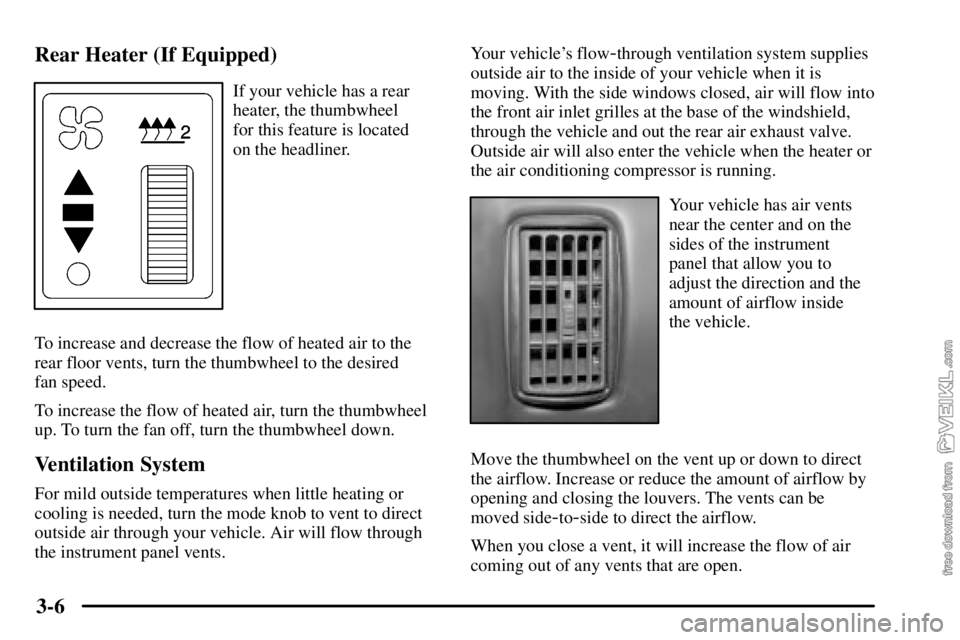Page 95 of 386

2-20 Cold Weather Starting
(Caterpillar
� Diesel)
Because the diesel engine uses compression ignition, it
is harder to start in cold weather than a gasoline engine.
The air intake heater and use of the proper engine oil,
optional engine coolant heaters and optional ether
injection systems help cold weather starting. See the
Caterpillar
� Diesel Engine Operation & Maintenance
Manual for more information.
NOTICE:
Your diesel engine has an electric air intake
heater system which reduces white smoke and
helps start the engine in cold weather. Do not
spray starting fluid into the air intake where it
can contact the heater elements.
If you don't have the GM Automatic Ether
Injection System, don't use starting fluid or you
could damage your engine. If you have the GM
system, use only GM approved starting fluid that
has been tested to establish compatibility with the
air inlet heater system.
Diesel Engine Warm-Up
Several factors affect how quickly your diesel engine
warms up. These can include outside temperature,
engine load, idle time and your vehicle's option content.
Your vehicle may be equipped with some features that
can help the engine reach operating temperature sooner.
Some of these features are discussed below.
Also, remember that an automatic transmission adds
heat to the cooling system through the heat exchanger in
the radiator. Because of this, vehicles equipped with
automatic transmissions are often able to retain engine
coolant heat better than manual transmission vehicles.
See your Caterpillar
� Operation & Maintenance manual
for additional diesel engine warm
-up information.
Page 171 of 386

3-2
Comfort Controls
This section tells you how to make your air system work
for you.
With these systems, you can control the heating, cooling
and ventilation in your vehicle.
Heater Controls
If your vehicle does not have air conditioning, the
control panel will look like this.
Fan Knob
The knob on the left side of the control panel regulates
the fan speed. The knob has four speeds. To increase
airflow, turn the knob clockwise. To decrease airflow,
turn it counterclockwise. To turn the fan off, turn the
mode knob on the far right all the way
counterclockwise.Temperature Knob
The middle knob on the control panel is used to adjust
the temperature of the air flowing into the passenger
area of your vehicle.
Turn the knob toward the red area for warmer air. Turn
the knob toward the blue area for cooler air.
Mode Knob
The knob on the right side of the control panel is used to
select the direction of the air flowing into the vehicle.
(Vent): This setting directs air through the
instrument panel vents.
(Bi-Level): This setting divides airflow between
the floor vents and instrument panel vents.
(Floor): This setting directs air through the
floor vents.
(Defog): This setting divides airflow between the
floor vents and windshield.
(Defrost): This setting directs air through the
windshield vents. This setting is used to remove fog or
ice from the windshield.
Page 172 of 386

3-3 Heater/Air Conditioning Controls
(If Equipped)
If your vehicle has air conditioning, the heater/air
conditioning control panel will look like this.
Fan Knob
The knob on the left side of the control panel regulates
the fan speed. It has four speeds.
To increase airflow, turn the knob clockwise. To
decrease airflow, turn it counterclockwise. To turn the
fan off, turn the mode knob on the far right all the way
counterclockwise.Temperature Knob
The middle knob on the control panel is used to adjust
the temperature of the air flowing into the passenger
compartment of your vehicle.
Turn the knob toward the red area for warmer air.
Turn the knob toward the blue area for cooler air.
Mode Knob
The knob on the right side of the control panel is used to
select the direction of the air flowing into the vehicle.
(Maximum Air Conditioning): Turn the right
knob to maximum air conditioning for maximum
cooling. This setting puts the system in the recirculation
mode and helps to maximize your air conditioner's
performance and your vehicle's fuel economy. This
setting also cools the air the fastest. After the vehicle's
interior reaches a comfortable temperature, turn the
knob clockwise to place the air conditioning system in
the regular air conditioning mode.
(Air Conditioning): This setting is used for
normal cooling on hot days. It cools outside air and
directs it through the instrument panel vents.
Page 175 of 386

3-6 Rear Heater (If Equipped)
If your vehicle has a rear
heater, the thumbwheel
for this feature is located
on the headliner.
To increase and decrease the flow of heated air to the
rear floor vents, turn the thumbwheel to the desired
fan speed.
To increase the flow of heated air, turn the thumbwheel
up. To turn the fan off, turn the thumbwheel down.
Ventilation System
For mild outside temperatures when little heating or
cooling is needed, turn the mode knob to vent to direct
outside air through your vehicle. Air will flow through
the instrument panel vents.Your vehicle's flow
-through ventilation system supplies
outside air to the inside of your vehicle when it is
moving. With the side windows closed, air will flow into
the front air inlet grilles at the base of the windshield,
through the vehicle and out the rear air exhaust valve.
Outside air will also enter the vehicle when the heater or
the air conditioning compressor is running.
Your vehicle has air vents
near the center and on the
sides of the instrument
panel that allow you to
adjust the direction and the
amount of airflow inside
the vehicle.
Move the thumbwheel on the vent up or down to direct
the airflow. Increase or reduce the amount of airflow by
opening and closing the louvers. The vents can be
moved side
-to-side to direct the airflow.
When you close a vent, it will increase the flow of air
coming out of any vents that are open.
Page 217 of 386
4-24
Hill and Mountain Roads
Driving on steep hills or mountains is different from
driving in flat or rolling terrain.Here are some tips that can make your drive through
steep country safer:
�Keep the vehicle in good shape. Check all fluid
levels and also the brakes, tires, cooling system and
transmission. These parts can work hard on
mountain roads.
�Know how to go down hills. The most important
thing to know is this: let your engine do some of the
slowing down. Shift to a lower gear when you go
down a steep or long hill.
CAUTION:
If you don't shift down, your brakes could get
so hot that they wouldn't work well. You would
then have poor braking or even none going
down a hill. You could crash. Shift down to let
your engine assist your brakes on a steep
downhill slope.
Page 226 of 386
5-
5-1
Section 5 Problems on the Road
Here you'll find what to do about some problems that can occur on the road.
5
-2 Hazard Warning Flashers
5
-3 Other Warning Devices
5
-3 Jump Starting
5
-10 Towing Your Vehicle
5
-17 Engine Overheating5
-20 Cooling System
5
-26 Engine Fan Noise
5
-26 If a Tire Goes Flat
5
-27 Changing a Flat Tire
5
-28 If You're Stuck: In Sand, Mud, Ice or Snow
Page 245 of 386
5-20
Cooling System
When you decide it's safe to lift the hood, here's what
you'll see:
A. Engine Fan
B. Coolant Surge Tank
If your vehicle has a Caterpillar diesel engine, see the
Caterpillar
� Diesel Engine Operation and Maintenance
Manual provided with your vehicle.If the coolant inside the coolant surge tank is boiling,
don't do anything else until it cools down. The vehicle
should be parked on a level surface.
The coolant level
should be at COLD
FILL or higher. If it
isn't, you may have a
leak at the pressure cap
or in the radiator
hoses, heater hoses,
radiator, water pump
or somewhere else in
the cooling system.
Page 246 of 386

5-21
CAUTION:
Heater and radiator hoses, and other engine
parts, can be very hot. Don't touch them. If you
do, you can be burned.
Don't run the engine if there is a leak. If you run
the engine, it could lose all coolant. That could
cause an engine fire, and you could be burned.
Get any leak fixed before you drive the vehicle.
If there seems to be no leak, start the engine again.
The engine cooling fan speed should increase when idle
speed is doubled by pushing the accelerator pedal
down. If it doesn't, your vehicle needs service.
Turn off the engine.
NOTICE:
Engine damage from running your engine
without coolant isn't covered by your warranty.
NOTICE:
When adding coolant, it is important that you use
only DEX
-COOL� (silicate-free) coolant.
If coolant other than DEX-COOL is added to
the system, premature engine, heater core or
radiator corrosion may result. In addition, the
engine coolant will require change sooner
-- at
30,000 miles (50 000 km) or 24 months,
whichever occurs first. Damage caused by the
use of coolant other than DEX
-COOL� is not
covered by your new vehicle warranty.